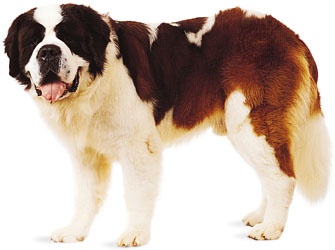Saint Bernard
breed of dog
 working dog credited with saving the lives of some 2,500 people in 300 years of service as pathfinder and rescue dog at the hospice founded by St. Bernard of Montjoux in Great St. Bernard Pass (Great Saint Bernard Pass) in the Pennine Alps. Probably descended from mastifflike dogs that were introduced from Asia to Europe by the Romans, the St. Bernard appears to have been brought to the hospice in the late 17th century. The most famous of the hospice dogs was Barry, who reportedly saved more than 40 people before his death in the early 1800s. Saint Bernards have also been employed as cattle, draft, and guard dogs.
working dog credited with saving the lives of some 2,500 people in 300 years of service as pathfinder and rescue dog at the hospice founded by St. Bernard of Montjoux in Great St. Bernard Pass (Great Saint Bernard Pass) in the Pennine Alps. Probably descended from mastifflike dogs that were introduced from Asia to Europe by the Romans, the St. Bernard appears to have been brought to the hospice in the late 17th century. The most famous of the hospice dogs was Barry, who reportedly saved more than 40 people before his death in the early 1800s. Saint Bernards have also been employed as cattle, draft, and guard dogs.A powerfully built, muscular dog with a massive head and drooping ears, the St. Bernard stands a minimum of 25 inches (63.5 cm) and weighs 110 to 200 pounds (50 to 91 kg). Its coat is red-brown and white or brindle and white and may be either short and dense or medium-long. The long-haired variety of St. Bernard was produced by crosses with the Newfoundland dog in the early 19th century.
- Dares Phrygius
- Dar es Salaam
- Dareste de la Chavanne, Antoine
- Daret, Jacques
- Dare, Virginia
- Darfur
- Dargomyzhsky, Aleksandr
- Darhan
- Darien
- Dari language
- Darin, Bobby
- Dario Fo
- Darius I
- Darius III
- Darius II Ochus
- Darius Milhaud
- Darién
- Darién, Gulf of
- Darjiling
- Dark Ages
- darkling beetle
- dark nebula
- Darlan, François
- Darley, George
- Darling Downs